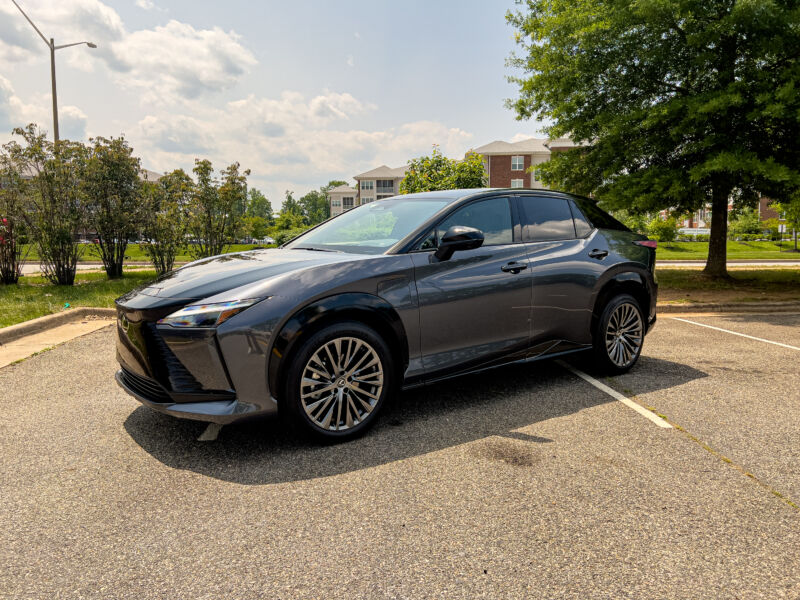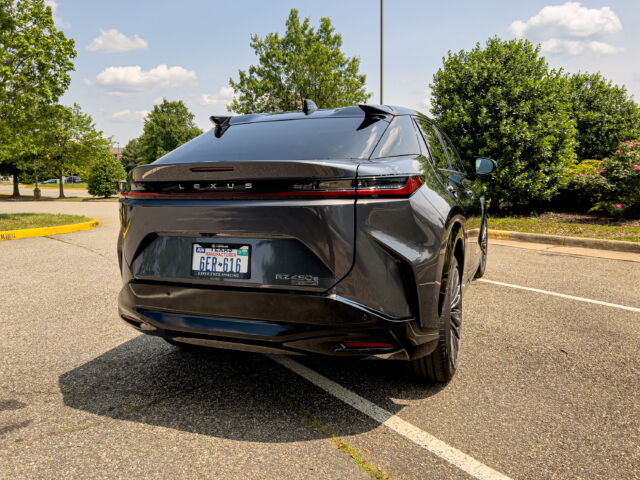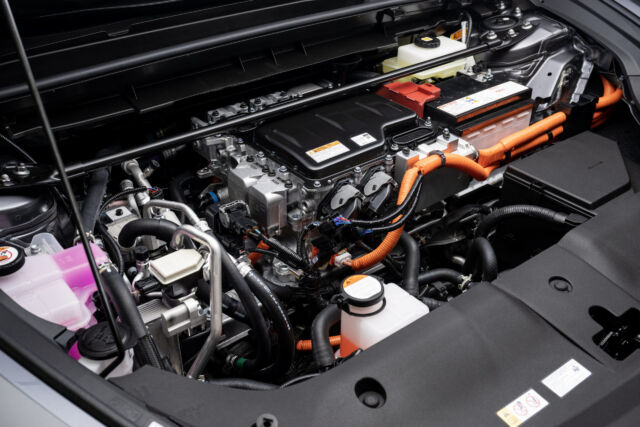
When Lexus started building luxury cars at the end of the 1980s, it took the rest of the auto industry a bit by surprise. Toyota wanted to show off that it could build the best car in the world, and the original Lexus LS400 was a credible effort to do just that. Three decades on, Lexus now has its first battery-electric vehicle. BEVs are Lexus’ future—it wants to sell a million of them by 2030, starting with this car, the 2023 RZ 450e. But don’t expect this electric Lexus to make the same kind of splash as the LS400 did—this is not a car that’s going to challenge for best in class.
It is fair to say that the industry-wide shift to battery-electric vehicles has caught out the world’s largest automaker. Toyota was an early front-runner when it came to electrification with hybrid powertrains—the Prius is now in its sixth iteration and has sold millions—but it has been much more cautious when it comes to BEVs. There was an early dalliance with the RAV4 EV, which showed up in small numbers in the US before being cancelled in 2002, and then not much until very recently. Now Toyota has developed its first modern BEV, using lithium-ion (rather than nickel-metal hydride), called the bZ4x. There’s a badge-engineered Subaru version, too, and this Lexus variant as well.
Design
Instead of starting with a clean-sheet design, like rival Volkswagen Group, Toyota decided to modify its existing modular vehicle architecture (called TNGA) to allow it to make BEVs (the new architecture is known as e-TNGA). I was going to write that it’s a relatively small crossover by 2023 standards until I checked the dimensions against other EVs; at 189.2 inches (4,806 mm) it’s actually longer than a Ford Mustang Mach-E, Volkswagen ID.4, or Jaguar I-Pace—perhaps the RZ 450e’s closest spiritual competitor. (It’s a pretty average 74 inches/1,880 mm wide and 64.4 inches/1,636 mm tall.)

The RZ’s shape is immediately familiar as a Lexus, embracing the brand’s current angular design style. It’s certainly a challenging car to photograph well!
Powertrain
The RZ 450e uses a twin-motor powertrain with a drive unit for each axle. Somewhat unusually for an all-wheel drive EV, this one has the more powerful drive unit at the front—in this case a 201 hp (150 kW), 194 lb-ft (263 Nm) permanent magnet synchronous motor, with a 107 hp (80 kW), 124 lb-ft (168 Nm) permanent magnet motor at the rear. Combined power output is always a function of the battery pack and often less than just adding the two motors’ outputs together, but in this case the RZ 450e does have a combined 308 hp (230 kW).
The lithium-ion battery pack lives between the axles. It’s supplied by Prime Planet and Energy Solutions and has a capacity of 71.4 kWh, although only 64 kWh of that is useable.
And that’s probably the RZ 450e’s biggest weakness. On 20-inch wheels, as in the case of our RZ 450e Luxury ($65,150, and there’s no IRS clean vehicle tax credit), Lexus says it should have a range of 196 miles (315 km). Unfortunately, even that appears to be highly optimistic; after charging our test car to 93 percent, it reported a mere 143 miles (230 km) of range.

When the car was dropped off, it had averaged 2.8 miles/kWh (22.2 kWh/100 km) over an unknown time frame—the trip computer is not particularly forthcoming with the details we would like. After about 150 miles of mixed city and highway driving, it reported an average of 3 miles/kWh (20.7 kWh/100 km), yet this was not reflected in the estimated range. By my math there’s about 36 miles’ (57 km) discrepancy between the theoretical range (miles/kWh x battery capacity) and the reported range. Lexus says that the RZ 450e Premium on 18-inch wheels ($59,650) should have a range of 220 miles (354 km).
Happily, charging proved to be pretty painless—certainly no guaranteed thing with a non-Tesla EV. I plugged into an Electrify America charger with 25 percent state of charge remaining, and 24 minutes later the car had reached 80 percent SoC. (To make things even better, the charger just worked, and I didn’t need to call the help line.) The charging session peaked at about 140 kW. Lexus says that 0-80 percent should take 30 minutes, and a level 2 charger will require 9.5 hours to completely recharge the battery from zero.
https://arstechnica.com/?p=1940414

